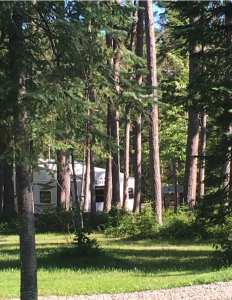 This is the ideal time to assess how your RV and trailer are doing so break it out of storage and check it out. Keep reading for more guidance and additional de-winterization maintenance tasks to prepare your RV for The Spring Camping Season.
This is the ideal time to assess how your RV and trailer are doing so break it out of storage and check it out. Keep reading for more guidance and additional de-winterization maintenance tasks to prepare your RV for The Spring Camping Season.
Basic Inspection & Safety Checks
You should first check your RV’s major systems to ensure it is roadworthy:
- power system
- propane system
- tire health
Make sure you do this early, so you have time to schedule any necessary maintenance before your first trip. Make certain that your carbon monoxide detector, smoke detector, LP detector, and fire extinguisher all work properly.
Check Electric Power
Look over all battery connections first. If they are corroded, disconnect the shore power and wear safety goggles and latex gloves when cleaning them off. Then, charge your batteries and check the fluid levels in the batteries, adding distilled water if necessary. If you have a generator, check it for nests and make sure the filter does not need to be replaced. A lack of fuel in the generator’s lines usually causes it to fail to start. Prime your generator by running the pump for about 20 seconds to deliver fuel to the carburetor. After that, it should start much more quickly. Once you have your generator running, check the oil level. Test all appliances on the electric setting.
Propane
Check the water heater (exterior of RV) closely in order to remove any debris from the burner tube. Make sure all of your propane appliances are turned off (furnace, stove, oven, refrigerator).
Visually inspect your propane system to make sure the seals and hoses aren’t cracked. If everything looks okay, open the valve on the tank(s) all the way. If you suspect a leak, use a soapy water solution around the valves and look for bubbles. Other important gear to have on hand is refillable RV propane tanks, alarms, and detectors. The last step is to ensure that your appliances are working properly using the propane settings. Be sure to inspect your propane appliances and furnace each spring when taking your RV out of storage.
Tires
If your tires (plus the spare) are in need of replacement, get them installed at your earliest convenience. Check the tires for proper inflation, inspect the sidewall for any cracks and the tread depth.
Dewinterize and Check Your Water Systems
The antifreeze will need to be drained and flushed from your system if you winterized it with non-toxic antifreeze. There are a couple of easy steps you can follow:
- If removed, re-insert the low point drain plugs.
- Replacing the anode rod with an Atwood water heater or the drain plug with a Suburban water heater is imperative if they have been neglected previously.
- The bypass water heater valves must be changed to “use” mode, which means closing the bypass valve and opening the hot and cold valves.
- The water system can be re-pressurized with a hose or at the pump by filling the freshwater tank and turning it on.
- To flush out the antifreeze in your system, open the faucets and the shower heads for indoor and outdoor use as well as the toilet.
- Then turn off the water pressure and remove the caps from the low point drains.
- Turn on the pressure again to flush out any of the remaining antifreeze in the system.
- Then turn off the water pressure to put the drain caps back on.
Test all valves, including faucets, outside shower, and toilet while you’re at it, including the water pump and city water hook-up.
Interior Inspection & Resupply
Clean the interior thoroughly. Drain any dehumidifiers (or replace any disposables). Check inside the cabinets and under the sinks for signs of rodents and pests. Now is a good time to go through all of your supplies and restock the camper with the essentials. If you discover any evidence of them, find the source and take care of it now before you add any new food items to the pantry.
Exterior Inspection & Wash
You should inspect the interior of your RV and climb up on the roof to check for chips, cracks, or missing caulking around exterior windows, doors, roof vents, and other seals. The awnings in your RV are exposed to the weather and rarely see sunlight, making them prone to mildew. Finally, rinse the RV well with a gentle biodegradable soap solution. Simply Green works well. To clean, use a soft bristle brush with the soap solution. Rinse well and let them air dry for a few hours before retracting.
All Systems Go!
Making sure these checks are run on your RV and performing any necessary maintenance will go a long way toward making your camping season a success.
